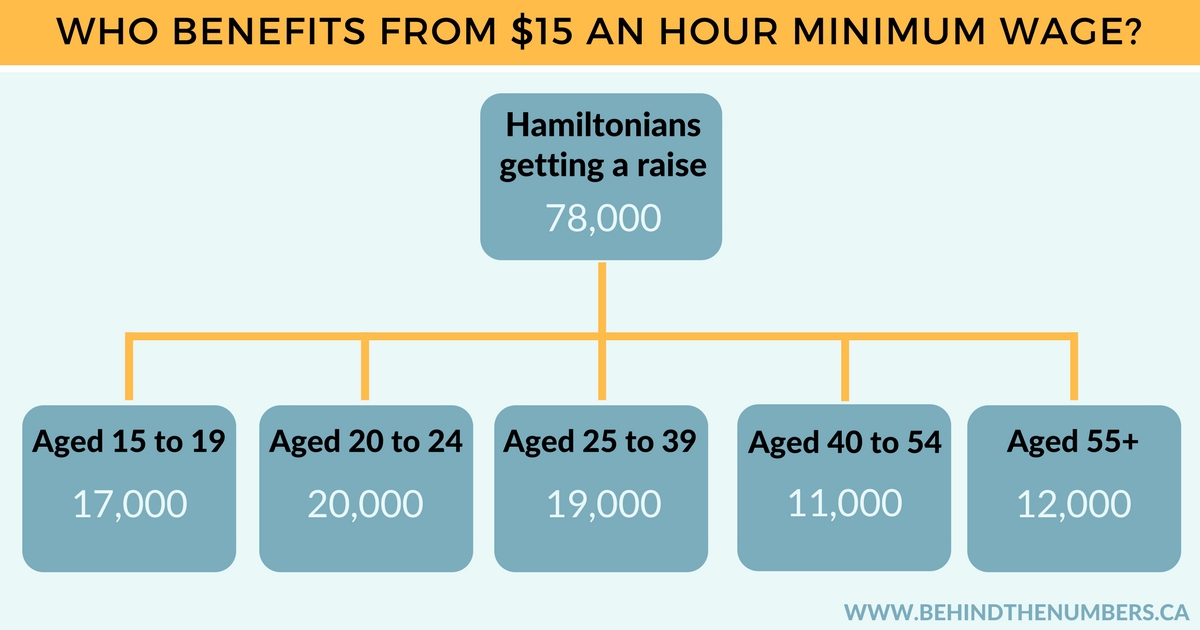Ontario’s big business lobbies continue their campaign against the government’s planned minimum wage hike—to $15 an hour by January 1, 2019 from the current rate of $11.40. They say the move is “arbitrary” and are threatening to flee the province unless the government backs down.
This kind of rhetoric was predictable and should be faced down as the empty threat that it is. At the end of the day, business will adjust and, as I presented in my report Ontario Needs a Raise, a quarter of Ontarians will get a badly needed and long overdue raise.
Who benefits from $15 an hour?
According to Statistics Canada’s Labour Force Survey (and my calculations), 78,000 Ontarians earning less than $15 an hour live in Hamilton. A majority are over 25 (53%) and 12,000 are seniors; 45,000 are women. Among the beneficiaries of a $15 minimum wage are 11,000 Hamiltonians with children under 18.
Hamiltonians will be getting a raise – predominantly in their prime working or senior years. A notable 53% of gainers are 25 and over, 12,000 of which are over 55 years-old. What’s more, the richest 1% of Hamiltonians saw a raise in the last year worth what a minimum wage earner working full year full-time would make even after moving to $15 an hour (which won’t happen for a year and a half).

Source: Labour Force Survey and author’s calculations.
A Hamiltonian working full time for a minimum wage beginning January 2019 would make $30,000 a year. Even those who don’t work full time may be pulled above the poverty line for the first time thanks to the pay increase. And among the more precariously employed, 37,000 part-time workers (54% of all part-timers in the city) will see a raise.In comparison, Hamilton’s richest have been enjoying hefty annual pay increases recently. In the past year of data (to 2014), Hamilton’s richest 1% got a raise of $31,000, with their pre-tax market earnings (including capital gains) rising from $463,000 to $494,000.
In other words, Hamilton’s richest 1% made in raises in one year what a $15-an-hour worker will make from a full year of full-time work. At least a few of these wealthy Hamiltonians will be the owners and managers of the businesses currently lobbying against the provincial government’s minimum wage hike.
Where do they work?
Hamiltonians getting a raise are concentrated in three industries: 19,000 work in retail, 17,000 work in accommodations/food services workers and 8,000 workers the cleaning, security, call centres or waste collection sectors. These jobs cannot be outsourced overseas—a fact that helps us call the big business bluff about skipping town.
Hamiltonians getting a raise overwhelmingly work for big box stores and chain restaurants, not mom & pop shops. In those three sectors, 62% of workers getting a raise work for big businesses with over 500 employees.
At the end of the day, all Hamiltonians, rich and not-so-rich, workers and employers, will benefit from the $15 minimum wage.
This blog is part of a series that examines who will benefit from a proposed move to $15 an hour minimum wage in Ontario. For a look at why the raise is good for Ontario workers, read CCPA Ontario director Trish Hennessy's take here. Data on how $15 minimum wage would benefit Ontario's Indigenous workers and families can be found here. Toronto-specific calculations are available online here.
David Macdonald is a senior economist with the Canadian Centre for Policy Alternatives. Follow him on Twitter @DavicMacCnd.






